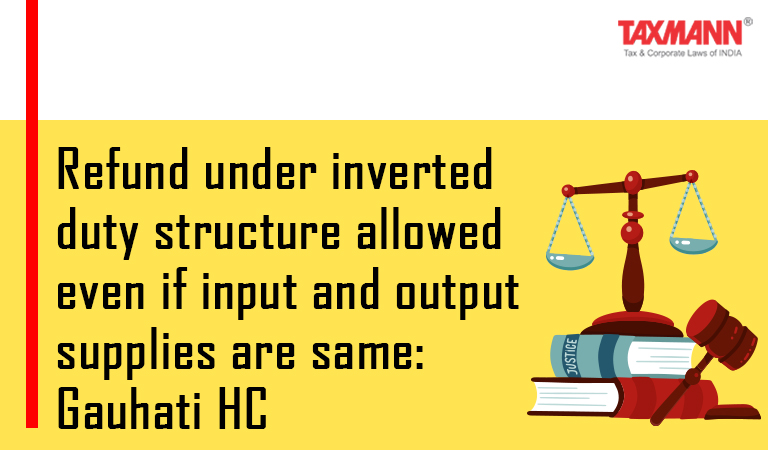Refund under inverted duty structure allowed even if input and output supplies are same: Gauhati HC
- Blog|News|GST & Customs|
- 2 Min Read
- By Taxmann
- |
- Last Updated on 14 September, 2021
Case details: BMG Informatics Pvt Ltd. v. Union of India - [2021] 130 taxmann.com 182 (Gauhati)
Judiciary and Counsel Details
-
- Achintya Malla Bujor Barua, J.
- S.C. Keyal for the Appellant.
- A. Saraf for the Appearing Parties.
Facts of the Case
The assessee was a company dealing with IT system integrator and is a service provider primarily engaged in sales and service of information and technology products. It submitted a claim for a refund but the same was rejected by Assistant Commissioner. The claim was rejected on ground that input and output supplies made by assessee were of same material and goods. Therefore, although rate of tax on input supply may be higher than rate of tax in output supply, but by referring to provisions of paragraph 3.2 of Circular No.135/05/2020-GST dated 31-3-2020, it was held that assessee was not entitled to refund being engaged in trading of technology related products not manufacturers. The appeal was against it and the Joint Commissioner (Appeals) held that the assessee was entitled to the benefit of refund of duty. The department filed writ petition against it.
High Court Held
The Honorable High Court observed that there was a conflict between provisions of paragraph 3.2 of Circular No.135/05/2020-GST dated 31-3-2020 with provisions of section 54(3)(ii) of CGST Act. The Section 54(3)(ii) provides that a refund of unutilized input tax credit would be available in event, rate of tax on input supplies is higher than rate of tax on output supplies. However, paragraph 3.2 of Circular No.135/05/2020-GST dated 31-3-2020 provides that even though different tax rate may be attracted at different point of time, but refund of accumulated unutilized tax credit will not be available under section 54(3)(ii) in cases where input and output supplies are same.
The honorable High Court held that whenever there is a conflict between provisions of a statutory Act and a notification or circular issued by an administrative authority, provisions of statutory Act would prevail over such conflicting provisions of a notification or a circular of an administrative authority. Thus, assessee was entitled to the benefit of refund of duty and provisions of paragraph 3.2 of Circular No.135/05/2020-GST dated 31-3-2020 would not be sustainable in law.
Disclaimer: The content/information published on the website is only for general information of the user and shall not be construed as legal advice. While the Taxmann has exercised reasonable efforts to ensure the veracity of information/content published, Taxmann shall be under no liability in any manner whatsoever for incorrect information, if any.

Taxmann Publications has a dedicated in-house Research & Editorial Team. This team consists of a team of Chartered Accountants, Company Secretaries, and Lawyers. This team works under the guidance and supervision of editor-in-chief Mr Rakesh Bhargava.
The Research and Editorial Team is responsible for developing reliable and accurate content for the readers. The team follows the six-sigma approach to achieve the benchmark of zero error in its publications and research platforms. The team ensures that the following publication guidelines are thoroughly followed while developing the content:
- The statutory material is obtained only from the authorized and reliable sources
- All the latest developments in the judicial and legislative fields are covered
- Prepare the analytical write-ups on current, controversial, and important issues to help the readers to understand the concept and its implications
- Every content published by Taxmann is complete, accurate and lucid
- All evidence-based statements are supported with proper reference to Section, Circular No., Notification No. or citations
- The golden rules of grammar, style and consistency are thoroughly followed
- Font and size that’s easy to read and remain consistent across all imprint and digital publications are applied






 CA | CS | CMA
CA | CS | CMA


